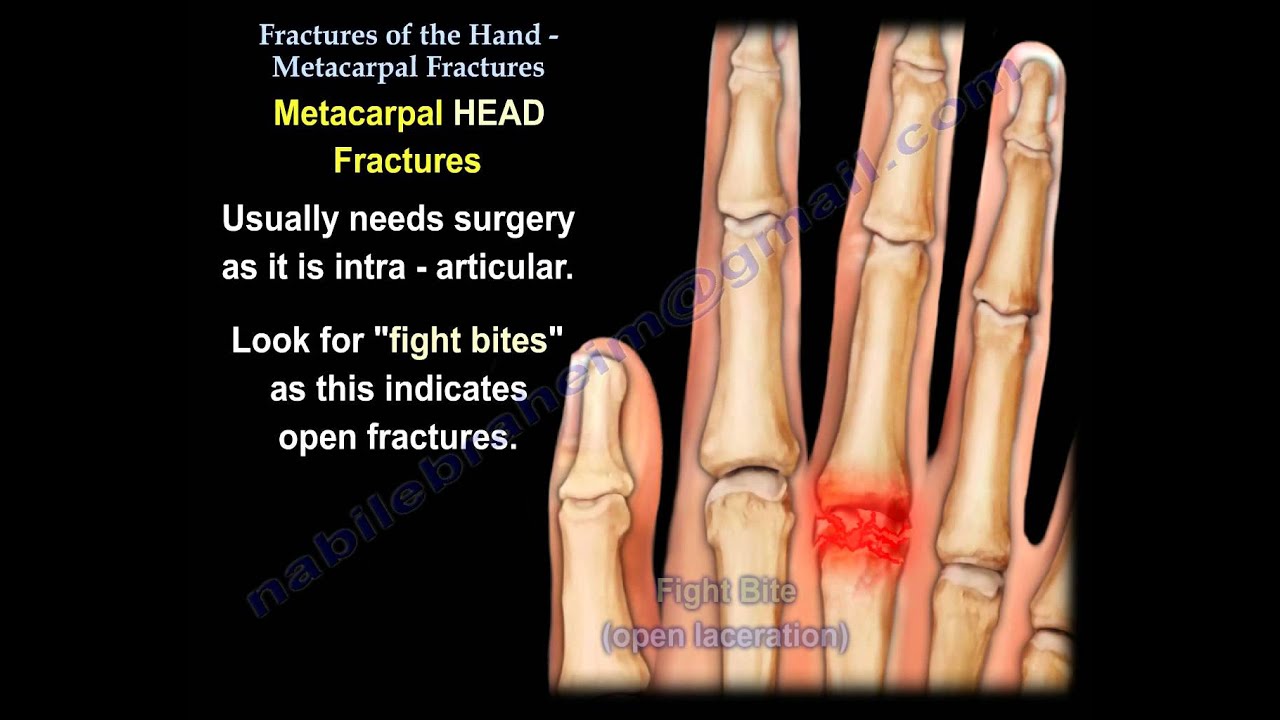Metacarpal Shaft Fractures - Causes, Symptoms, Treatment, And Recovery
Metacarpal shaft fractures are a common type of hand injury that occurs when one or more of the long bones in the hand, known as metacarpals, are fractured along their shafts.
Author:Suleman ShahReviewer:Han JuApr 07, 2023205 Shares2.8K Views

Metacarpal shaft fracturesare a common type of hand injury that occurs when one or more of the long bones in the hand, known as metacarpals, are fractured along their shafts.
This type of injury can occur from a variety of causes, such as sports injuries, falls, and accidents. Metacarpal shaft fractures can cause pain, swelling, and loss of function in the hand, and may require medical intervention to heal properly.
In this article, we will discuss the causes, symptoms, diagnosis, treatment, and prevention of metacarpal shaft fractures.
What Are Metacarpal Shaft Fractures?
Metacarpal shaft fractures refer to the breakage or damage of one or more of the long bones (metacarpals) located in the hand, between the wrist and the fingers.
These fractures are commonly caused by direct trauma or impact to the hand, such as punching a hard object, a fall onto an outstretched hand, or a sports-related injury.
Metacarpal shaft fractures can range from minor hairline cracks to complete bone breaks and can result in significant pain, swelling, and deformity of the hand.
Depending on the severity of the fracture, treatment options can include immobilization, casting, surgery, or a combination of these approaches.

Metacarpal Fractures - Everything You Need To Know - Dr. Nabil Ebraheim
Metacarpal Shaft Fractures Causes
Metacarpal shaft fractures are typically caused by a direct impact or forceful blow to the hand. This can occur during sports activities, such as football, basketball, or martial arts, or during high-impact activities, such as a fall onto an outstretched hand.
Other causes may include car accidents or physical altercations. Certain medical conditions, such as osteoporosis, can also weaken the bones and make them more prone to fractures.
Additionally, repetitive stress and overuse injuries can also contribute to the development of metacarpal shaft fractures over time.
Metacarpal Shaft Fractures Symptoms
Metacarpal shaft fractures are a type of hand fracture that can result from a variety of causes, such as a direct blow to the hand or a fall on an outstretched hand.
The metacarpals are the five long bones in the hand that connect the wrist bones to the fingers. A fracture in the shaft of the metacarpal bone can cause significant pain and affect hand function.
Here are some common symptoms of metacarpal shaft fractures:
- Pain- Pain is the most common symptom of a metacarpal shaft fracture. The pain is usually severe and may be described as a sharp, shooting pain.
- Swelling- Swelling may occur around the fracture site and may be accompanied by bruising.
- Deformity- A visible deformity may be present in the hand, especially if the fracture is severe.
- Difficulty gripping or holding objects- A fracture in the metacarpal bone can affect the strength and flexibility of the hand, making it difficult to grip or hold objects.
- Limited range of motion- In some cases, a metacarpal shaft fracture may cause a limited range of motion in the hand, especially if the fracture is severe or if there is a dislocation.
Metacarpal Shaft Fractures Treatment
Metacarpal shaft fractures, which refer to fractures in the long part of the metacarpal bone, can be treated in a variety of ways depending on the severity and location of the fracture. Here are some common treatments for metacarpal shaft fractures:
- Immobilization- For less severe fractures, a cast, splint or brace may be used to immobilize the affected hand and allow the fracture to heal.
- Reduction- If the fracture is displaced or unstable, a doctor may need to manually realign the bone, a process known as reduction.
- Surgery- Surgery may be necessary for more severe fractures or fractures that are not healing properly. During surgery, a metal plate, screws, or pins may be used to hold the bones in place while they heal.
- Rehabilitation- Once the fracture has healed, rehabilitation exercises may be recommended to restore strength and range of motion to the affected hand.
- Pain management- Pain medication or anti-inflammatory drugs may be prescribed to manage pain and reduce inflammationduring the healing process.
It is important to seek medical attention if you suspect you have a metacarpal shaft fracture, as untreated fractures can lead to long-term complications such as arthritis or chronic pain.
Metacarpal Shaft Fractures Surgery
Metacarpal shaft fractures can be treated with both non-surgical and surgical methods. The treatment plan depends on various factors such as the severity of the fracture, location of the fracture, and the patient's age, occupation, and hand dominance.
Non-Surgical Treatment
- Immobilization- A cast or splint can be used to immobilize the fractured bone and promote healing.
- Medications- Pain relievers and anti-inflammatory medications may be prescribed to alleviate pain and swelling.
- Physical therapy- Exercises to maintain range of motion and strengthen the hand and fingers may be recommended.
Surgical Treatment
- Closed reduction and percutaneous pinning- This involves realigning the fractured bone without making an incision and fixing the bone with pins inserted through the skin.
- Open reduction and internal fixation- This involves making an incision to realign the fractured bone and fix it with metal plates, screws, or wires.
- External fixation- This method involves the use of an external frame that is attached to the bone with pins, which helps to stabilize the fracture and allow it to heal.
The choice of surgery depends on the severity of the fracture and the surgeon's preference.
After the surgery, the patient will need to undergo physical therapy to regain strength and motion in their hand. The recovery time varies depending on the type of surgery and the patient's overall health.
Metacarpal Shaft Fractures Recovery Time
The recovery time for metacarpal shaft fractures can vary depending on the severity of the fracture and the treatment method used. In general, it may take several weeks to several months for the bone to heal completely.
Non-surgical treatment methods, such as immobilization with a cast or splint, typically require a shorter recovery time, usually around 4 to 6 weeks.
During this time, it is important to avoid using the affected hand for strenuous activities.
Surgical treatment, such as internal fixation with pins, plates, or screws, may require a longer recovery time.
The recovery period can range from 6 to 12 weeks, and the hand may need to be immobilized during this time to allow the bone to heal properly.
Physical therapy may be recommended to help restore range of motion and strength to the affected hand once the bone has healed.
The duration and frequency of physical therapy will vary depending on the individual's condition and the severity of the fracture.
People Also Ask
How Is A Metacarpal Shaft Fracture Diagnosed?
A metacarpal shaft fracture is diagnosed through a physical examination of the hand, x-rays, and potentially a CT scan or MRI if the fracture is severe.
How Long Does It Take To Recover From A Metacarpal Shaft Fracture?
The recovery time for a metacarpal shaft fracture depends on the severity of the fracture and the individual's healing process. Generally, it takes about 6-8 weeks for the bone to fully heal and rehabilitation may be needed to restore strength and mobility.
Can A Metacarpal Shaft Fracture Heal On Its Own?
Some small metacarpal shaft fractures can heal on their own with immobilization and rest. However, larger or more complex fractures may require surgical intervention to ensure proper healing.
What Is The Treatment For A Metacarpal Shaft Fracture?
Treatment for a metacarpal shaft fracture depends on the severity of the fracture. Non-surgical treatment options include immobilization with a cast or brace, while surgical options include open reduction and internal fixation or external fixation.
What Causes A Metacarpal Shaft Fracture?
Metacarpal shaft fractures are often caused by direct impact to the hand, such as during sports or a fall. They can also occur due to repetitive stress or underlying conditions such as osteoporosis.
Final Thought
Metacarpal shaft fractures are a common type of hand injury that can affect individuals of all ages and activity levels. These fractures can result from a variety of causes, such as falls, sports injuries, or motor vehicle accidents. If left untreated, metacarpal shaft fractures can lead to long-term complications such as malunion or nonunion of the bone. Therefore, early diagnosis and proper treatment are essential for a successful recovery. Treatment options may include immobilization with a cast or splint, surgical intervention, or a combination of both. With proper care and management, individuals with metacarpal shaft fractures can expect a full recovery and return to their normal activities.

Suleman Shah
Author
Suleman Shah is a researcher and freelance writer. As a researcher, he has worked with MNS University of Agriculture, Multan (Pakistan) and Texas A & M University (USA). He regularly writes science articles and blogs for science news website immersse.com and open access publishers OA Publishing London and Scientific Times. He loves to keep himself updated on scientific developments and convert these developments into everyday language to update the readers about the developments in the scientific era. His primary research focus is Plant sciences, and he contributed to this field by publishing his research in scientific journals and presenting his work at many Conferences.
Shah graduated from the University of Agriculture Faisalabad (Pakistan) and started his professional carrier with Jaffer Agro Services and later with the Agriculture Department of the Government of Pakistan. His research interest compelled and attracted him to proceed with his carrier in Plant sciences research. So, he started his Ph.D. in Soil Science at MNS University of Agriculture Multan (Pakistan). Later, he started working as a visiting scholar with Texas A&M University (USA).
Shah’s experience with big Open Excess publishers like Springers, Frontiers, MDPI, etc., testified to his belief in Open Access as a barrier-removing mechanism between researchers and the readers of their research. Shah believes that Open Access is revolutionizing the publication process and benefitting research in all fields.

Han Ju
Reviewer
Hello! I'm Han Ju, the heart behind World Wide Journals. My life is a unique tapestry woven from the threads of news, spirituality, and science, enriched by melodies from my guitar. Raised amidst tales of the ancient and the arcane, I developed a keen eye for the stories that truly matter. Through my work, I seek to bridge the seen with the unseen, marrying the rigor of science with the depth of spirituality.
Each article at World Wide Journals is a piece of this ongoing quest, blending analysis with personal reflection. Whether exploring quantum frontiers or strumming chords under the stars, my aim is to inspire and provoke thought, inviting you into a world where every discovery is a note in the grand symphony of existence.
Welcome aboard this journey of insight and exploration, where curiosity leads and music guides.
Latest Articles
Popular Articles